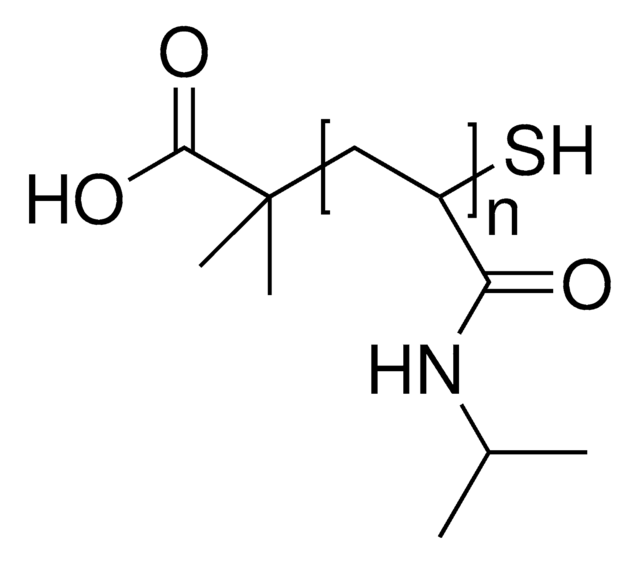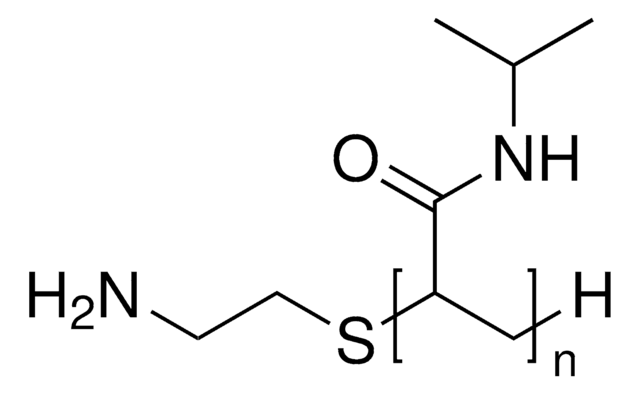PNIPAM is soluble in organic solvents, such as chloroform, acetone, methanol, and various other alcohols. It is also soluble in water, as long as the solution is kept reasonably cold. Please see the link below to review additional information regarding this compound:
https://www.sigmaaldrich.com/US/en/technical-documents/technical-article/materials-science-and-engineering/polymer-synthesis/poly-n-isopropylacrylamide
推薦產品
應用
Poly(N-isopropyl acrylamide) (PolyNIPAM) is a stimuli-responsive polymer[1]. This product features low polydispersity (PDI), which typically leads to better reproducibility in applications, and a terminal N-hydroxysuccinimide (NHS) functional group, allowing for rapid conjugation of biomolecules, small molecules, or other polymers. PolyNIPAM has been used in development of a variety of thermosensitive coated micro/nano materials, including thermoresponsive polymeric drug delivery systems[2][3].
儲存類別代碼
11 - Combustible Solids
水污染物質分類(WGK)
WGK 3
閃點(°F)
Not applicable
閃點(°C)
Not applicable
Avraham Halperin et al.
Langmuir : the ACS journal of surfaces and colloids, 28(48), 16623-16637 (2012-11-06)
Thermoresponsive tissue culture substrates based on PNIPAM brushes are used to harvest confluent cell sheets for tissue engineering. The prospect of clinical use imposes the utilization of culture medium free of bovine serum, thus suggesting conjugation with adhesion peptides containing
Umut Atakan Gurkan et al.
Advanced healthcare materials, 1(5), 661-668 (2012-11-28)
Stimuli responsive, smart interface materials are integrated with microfluidic technologies creating new functions for a broad range of biological and clinical applications by controlling the material and cell interactions. Local capture and on-demand local release of cells are demonstrated with
Shahrzad Rayatpisheh et al.
Macromolecular bioscience, 12(7), 937-945 (2012-04-27)
A new method for ultrathin grafting of pNIPAm on PDMS surfaces is introduced that employs plasma activation of the surface followed by thermal polymerization. This method is optimized for human primary SMC attachment and subsequent intact cell sheet detachment by
A C C Rotzetter et al.
Advanced materials (Deerfield Beach, Fla.), 24(39), 5352-5356 (2012-08-31)
Buildings can be effectively cooled by a bioinspired sweating-like action based on thermoresponsive hydrogels (PNIPAM), which press out their stored water when exceeding the lower critical solution temperature. The surface temperature is reduced by 15 °C compared to that of
Manuel Pernia Leal et al.
ACS nano, 6(12), 10535-10545 (2012-11-03)
We report a procedure to grow thermo-responsive polymer shells at the surface of magnetic nanocarriers made of multiple iron oxide superparamagnetic nanoparticles embedded in poly(maleic anhydride-alt-1-ocatadecene) polymer nanobeads. Depending on the comonomers and on their relative composition, tunable phase transition
文章
Professor Mitsuhiro Ebara provides insights on several types of smart nanofiber mesh systems that have been explored for different drug delivery purposes.
-
Hi, What is a good solvent for this chemical?
1 answer-
Helpful?
-
Active Filters
我們的科學家團隊在所有研究領域都有豐富的經驗,包括生命科學、材料科學、化學合成、色譜、分析等.
聯絡技術服務







